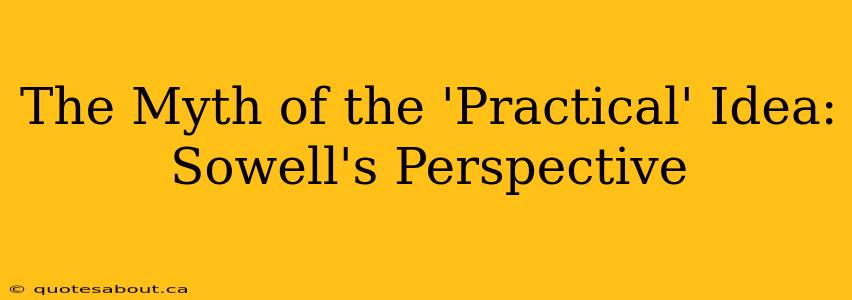The Myth of the 'Practical' Idea: Sowell's Perspective
Thomas Sowell, the renowned economist and social theorist, often challenged the common assumption that "practical" ideas are inherently superior to theoretical ones. He argued that the very definition of "practical" is often subjective and clouded by unexamined biases, leading to flawed decision-making and a neglect of potentially transformative solutions. This essay explores Sowell's perspective on the myth of the "practical" idea, examining how seemingly pragmatic approaches can mask hidden costs and unintended consequences.
What does Sowell mean by "practical"?
Sowell doesn't dismiss practicality entirely. Instead, he challenges the narrow and often unexamined way the term is used. For Sowell, "practical" often signifies a preference for incremental change, maintaining the status quo, or solutions rooted in immediate, visible benefits. This approach, he argues, overlooks the long-term implications and the potential for more ambitious, yet seemingly "impractical," solutions to yield superior outcomes. He points out that what seems "practical" today might be seen as short-sighted and even counterproductive in the future. He emphasizes the need to consider the broader context, the underlying principles, and potential unintended consequences before labeling an idea as "practical."
Are "practical" solutions always the best?
No, according to Sowell. He provides numerous examples where seemingly "impractical" ideas, initially dismissed as unrealistic or too far-fetched, have ultimately revolutionized society. Technological advancements, for instance, often begin as theoretical concepts, deemed impractical until proven otherwise. The initial skepticism surrounding the internet, the airplane, or even the lightbulb illustrates this point. These weren't merely incremental improvements; they were paradigm shifts born from ideas that challenged existing limitations. Focusing solely on what's "practical" within the confines of current understanding can stifle innovation and progress.
How do biases affect our perception of "practicality"?
Sowell highlights the role of biases in shaping our perception of practicality. Our existing beliefs, values, and vested interests heavily influence what we consider practical. A solution might appear practical if it aligns with our pre-conceived notions, regardless of its actual effectiveness or long-term consequences. Conversely, ideas that challenge the status quo or threaten established interests might be dismissed as impractical, even if they offer superior solutions. This inherent subjectivity in evaluating practicality necessitates a critical examination of our own biases and assumptions.
What are the hidden costs of "practical" solutions?
Often, the focus on short-term, readily apparent benefits obscures the long-term costs. A "practical" solution might address an immediate problem but create new, more significant problems down the line. Sowell advocates for a comprehensive cost-benefit analysis that considers both the immediate and long-term implications, including intangible factors like social equity and environmental sustainability. Simply because a solution is easy to implement doesn't necessarily mean it's the most effective or ethical.
How can we overcome the myth of the 'practical' idea?
Sowell encourages a more rigorous and nuanced approach to evaluating ideas. He champions a framework that values intellectual rigor, considers diverse perspectives, and embraces a long-term vision. This requires:
- Critical thinking: Questioning assumptions and biases regarding what constitutes a "practical" solution.
- Comprehensive analysis: Conducting thorough cost-benefit analyses that encompass both short-term and long-term effects.
- Openness to new ideas: Embracing innovative solutions, even if they initially seem unrealistic or challenging.
- Understanding unintended consequences: Anticipating and mitigating potential negative impacts of any chosen solution.
By challenging the myth of the "practical" idea, Sowell urges us to broaden our horizons and consider a wider range of possibilities, ultimately leading to more effective and sustainable solutions for societal challenges. He reminds us that true practicality lies not in simply maintaining the status quo but in pursuing the best possible outcomes, even if those outcomes require challenging conventional wisdom and embracing seemingly "impractical" approaches.

